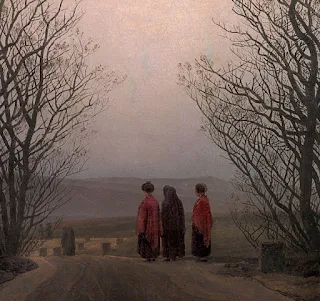 |
| Presumably a Roman Catholic monastery that fell on hard times after the Protestant Reformation. Unable to command economic subsidies from the surrounding communities, it slipped back to nature. |
Caspar David Friedrich born 1774 in Swedish Pomerania (which at various times has been Polish and German territory). Died 1840.
Friedrich was a commercial success early in his career. Friedrich belonged to the "Romanticism" school of painting and the public wanted those kinds of paintings.
It is easy to see the similarities between Friedrich's work and those of the later Hudson River School. For the most part, humans are dwarfed by sweeping vistas of wilderness.
Unfortunately, Friedrich was not able to adapt when "Romanticism" went out of fashion. He had is fifteen minutes (years) of fame and died a poor man.
Friedrich's work had a revival in popularity in the 1920. In the 1930s it caught the attention of the dominant political party in Germany, the NAZI. By the mid-1940s Friedrich's work was once again shunned.
Then, in the 1970s Friedrich's work was pulled out of the cellars and attics and displayed in museums.





I do like landscapes, ERJ. Thanks for sharing.
ReplyDeleteNice. Pity the man didn't see success during his life.
ReplyDeleteHe did. But he peaked early.
Delete